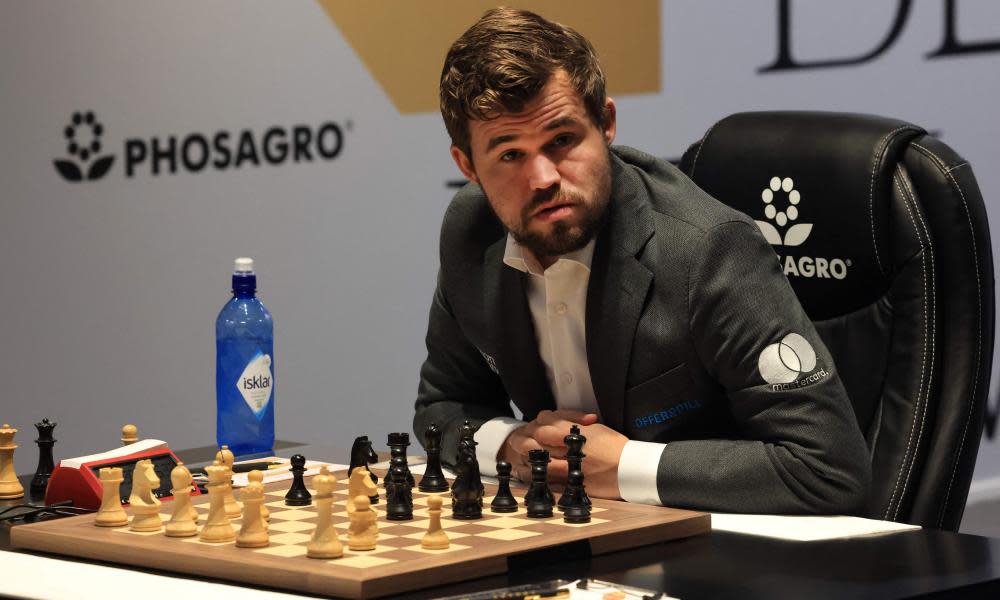Rare Nepomniachtchi error allows Carlsen to escape with another draw

Challenger rues missed opportunity to push home his position
Half-point agreed after 3hr 50min, leaving match at 2½-2½
Norway’s Magnus Carlsen and Russia’s Ian Nepomniachtchi are no closer to a verdict in their €2m world championship match after playing to a fifth successive draw on Wednesday at the Dubai Exposition Centre.
Supercomputers evaluating the moves from the opening four games had indicated it was the most accurate world title match ever played in the event’s history and this fifth contest maintained that standard as the players remarkably combined for one inaccuracy between them. Regrettably for the 31-year-old challenger, the lapse was the opportunity Carlsen needed to escape from a highly uncomfortable position as black and negotiate a draw after 43 moves.
Related: Carlsen and Nepomniachtchi in fifth draw at World Chess Championship – as it happened
The contestants blitzed out their first moves after the same anti-Marshall variation of the Ruy Lopez from Nepomniachtchi’s two previous games with the white pieces (1 e4 e5 2 Nf3 Nc6 3 Bb5 a6 4 Ba4 Nf6 5 O-O Be7 6 Re1 b5 7 Bb3 O-O). After 8 a4, Carlsen continued his strategy of being first to divert from the familiar, initially with the rare (8 ... Rb8) and soon after with the new (13 ... d5), but Nepomniachtchi’s pace and accuracy in response suggested he was prepared for both.
The champion began exhausting more and more time on his moves, falling behind more than three-quarters of an hour on the clock after spending nearly 20 minutes deciding on 19 … Qe8. But Nepomniachtchi’s decision to play 20 Red1 instead of c4 was, Carlsen confessed, an enormous relief.
“I definitely considered [c4] the main option,” said Carlsen, who turned 31 on Tuesday. “I thought everything else was kind of manageable. Obviously it’s always a bit worse, but it feels like my position is not going to get worse, it’s going to probably gradually improve seeing as I have very few real weaknesses. [c4] was definitely what was worrying me the most there. Seeing Rd1, I kind of thought that the worst was over.”
From there Carlsen was able to rely on his tactical acumen and instinct to simplify the position and come away with a half-point after 3hr 50min, leaving Nepomniachtchi to rue his missed chance to take the match by the scruff. “Of course I’m disappointed,” the world No 5 said. “Today is basically not about him defending well but me not using all the opportunities I had.”
The match consists of 14 classical games, with each player awarded one point for a win and half a point for a draw. Whoever reaches seven and a half points first will be declared the champion.
The time control for each game is 120 minutes for the first 40 moves, 60 minutes for the next 20 moves and then 15 minutes for the rest of the game plus an additional 30 seconds per move starting from move 61.
If the match is tied after 14 games, tiebreaks will be played on the final day (16 December) in the following order:
• Best of four rapid games with 25 minutes for each player with an increment of 10 seconds after each move.
• If still tied, they will play up to five mini-matches of two blitz games (five minutes for each player with a three-second increment).
• If all five mini-matches are drawn, one sudden-death ‘Armageddon’ match will be played where White receives five minutes and Black receives four minutes. Both players will receive a three-second increment after the 60th move. In the case of a draw, Black will be declared the winner.
Carlsen’s second and third title defences both came down to tiebreakers. But many believe the increased length of this year’s match (from 12 to 14 games) and the stylistic matchup at hand promises a decisive result in regulation.
The bloodless result, which left the best-of-14 match in a 2½-2½ deadlock with nine contests remaining, extended a streak of 17 consecutive draws in classical world championship games. Carlsen drew the final two games with Sergey Karjakin in 2016, all 12 against Fabiano Caruana in 2018, then five straight to open this year’s tie with Nepomniachtchi.
“I think there is some magical cutoff point where draws instead of just being normal, they become a problem,” said Carlsen, who will marshal the white pieces when play resumes on Friday afternoon after a rest day on Thursday. “But I don’t think we’ve crossed the Rubicon yet.”

 Yahoo Movies
Yahoo Movies 
